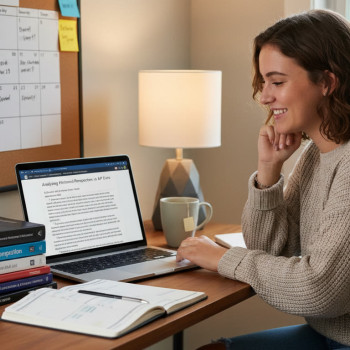AP vs SAT: The Big Question Can You Self-Study Successfully?
If you re a student (or a parent shepherding a student) standing at the crossroads of AP classes and the Digital SAT, you ve probably asked: Do I need a tutor, or can I honestly self-study? Short answer: yes many students succeed studying on their own. Longer answer: it depends on what you re aiming for, your starting point, your learning style, and how well you structure deliberate practice. This article unpacks those variables, highlights high-quality free resources, gives sample schedules, and explains when personalized support like Sparkl s 1-on-1 guidance, tailored study plans, and AI-informed insights can make a strategic difference.

Why Compare AP and SAT At All?
AP exams and the Digital SAT serve different purposes but both matter for college pathways. AP classes and their exams let you demonstrate college-level mastery in specific subjects potentially earning college credit. The SAT is a standardized, college-admissions exam that offers a snapshot of college-readiness skills in reading, writing, and math. Comparing them helps you prioritize time, choose resources, and decide whether to rely on self-study or bring in a tutor.
Core Differences at a Glance
- Scope: AP = subject-specific depth. SAT = broad skills across subjects.
- Scoring: AP = score 1 5 per subject. SAT = scaled score (Digital SAT uses a different scoring model than earlier editions, but still yields a composite score used by colleges).
- Timing and Frequency: AP exams happen each May; the SAT is offered multiple times through the year (digital format dates vary by region).
- Skills Tested: APs test content knowledge and application; the SAT measures reading comprehension, evidence-based writing, and mathematical reasoning.
Is Self-Study Realistic? The Two Main Paths
When students say self-study, they usually mean one of two things:
- Independent self-study: Using books, free online materials, and practice tests to prepare without scheduled coaching.
- Guided self-study: Following a structured plan (sometimes provided by a program or a tutor) while doing most of the day-to-day practice independently.
Both paths can work well. The deciding factors are discipline, knowledge gaps, and whether you benefit from external accountability or expert feedback.
When Self-Study Is Likely to Work
- You re already doing well in the class (for AP) or you have a strong foundational skill set (for SAT math and reading).
- You can schedule regular practice and realistic benchmarks.
- You use high-quality practice materials and timed tests to simulate the real thing.
- You actively review mistakes and adapt study strategies (not just passively reading).
When to Consider Extra Help
- You ve plateaued despite steady practice.
- You have major content gaps (e.g., Algebra fundamentals before a calculus-based AP or SAT math struggles).
- You prefer feedback, pacing, and motivation areas where a tutor s 1-on-1 attention pays off.
Free Resources That Actually Help
One of the most encouraging things about modern test prep is the wealth of excellent free tools if you choose wisely. Below are categories of free resources and how to use them effectively.
Official Practice Tests and Guided Tools
Start with official practice materials whenever available. Official tests mirror real exam format and difficulty, which is crucial for realistic practice and timing. Use full-length, timed practice tests early and regularly to track growth.
Open Educational Content and Review Videos
Short video lessons and topic-based explanations are great for refreshing tricky concepts think targeted reviews for AP Biology units or algebraic techniques for the SAT. Combine videos with active note-taking and practice problems.
Active Practice Platforms
Look for platforms that let you practice adaptive question sets, track progress, and provide answer explanations. Whatever you choose, prioritize platforms that force you to explain mistakes and revisit weak topics in spaced intervals.
Community and Peer Resources
Study groups, online forums, and class peers can help with accountability and diverse problem explanations. Just ensure the answers you get from peers are verified use an official explanation or trusted textbook to confirm.
Practical Comparison Table: AP vs SAT for Self-Study
| Factor | AP Exams | Digital SAT |
|---|---|---|
| Focus | Deep subject mastery (e.g., AP U.S. History, AP Calculus) | General college-readiness skills in Reading/Writing and Math |
| Best for self-study if | You already have course instruction or strong motivation to learn content deeply | You have steady practice habits and can improve strategy and pacing through mock tests |
| Typical free resources | Official course descriptions, released free-response questions, topical outlines | Official practice tests, diagnostic tools, skill drill sets |
| Common challenge | Writing sustained essays and mastering lab-based or synthesis tasks | Timing on adaptive sections and mastering question types under digital format |
| When to seek tutoring | If you need feedback on essays, AP lab skills, or conceptual loops | If you need targeted strategy work, pacing mastery, or score jumps under deadline |
How to Build a Self-Study Plan That Actually Works
Good study is less about hours and more about structure. Here s a flexible blueprint that fits both AP and SAT prep.
Step 1 Start With a Diagnostic
- Take at least one full-length timed practice test for the SAT or a released AP exam/section for AP subjects.
- Identify recurring mistakes: timing issues, specific content gaps, or careless errors.
Step 2 Create a 12-Week Block Plan
For many students, a 12-week plan is a manageable block that balances content review and practice testing. Here s a compact template:
- Weeks 1 4: Content review and targeted practice on weak areas (3 5 sessions per week)
- Weeks 5 8: Mixed practice and strategy work; introduce timed sections (3 4 sessions per week + 1 full practice test every 2 weeks)
- Weeks 9 12: Test simulation and refinement; weekly full practice tests, focused review of errors, and final pacing drills
Step 3 Use Active Review
When you review wrong answers, do the work to understand them. Re-solve problems without looking, write short error summaries, and create mini-drills for the concepts you miss most.
Step 4 Simulate Test Conditions
Practice in test-like conditions: timed sessions, minimal breaks, and the same device or test-taking environment you ll use on test day. For the Digital SAT, practicing on a tablet or laptop to mimic the interface pays off.
Sample Weekly Schedules
Below are sample schedules for two typical students: one prepping an AP subject while taking the SAT, and another focused primarily on SAT improvement.
Student A: AP-Focused With SAT on the Side (10 12 Weeks)
- Mon: AP content review (60 90 minutes)
- Tue: SAT targeted practice (30 45 minutes) + Vocabulary/reading drill (20 minutes)
- Wed: AP practice questions and free-response plan (60 90 minutes)
- Thu: SAT math drills (60 minutes)
- Fri: Light review or catch-up (30 60 minutes)
- Sat: Full practice test every other week or mixed timed sections (2 4 hours)
- Sun: Rest or active review of mistakes (45 60 minutes)
Student B: SAT-Focused (8 12 Weeks)
- Mon: Reading passages + targeted question types (60 minutes)
- Tue: Math fundamentals and practice sets (60 90 minutes)
- Wed: Writing and grammar drills; short essay strategy if needed (45 60 minutes)
- Thu: Mixed timed section practice (60 minutes)
- Fri: Review errors and quick drills (30 45 minutes)
- Sat: Full practice test weekly (3 4 hours)
- Sun: Active review and light rest (45 60 minutes)
When Personalized Tutoring Makes Strategic Sense
Self-study is powerful, but targeted coaching accelerates improvement when used for the right reasons. A tutor can:
- Diagnose and prioritize specific weaknesses instead of a scattershot study routine.
- Provide real-time feedback on writing, problem-solving approach, and test strategy.
- Offer accountability and pacing especially helpful in the final weeks before an exam.
Sparkl s personalized tutoring is worth considering when you want 1-on-1 guidance that includes tailored study plans, expert tutors who can give precise feedback, and AI-driven insights that pinpoint the highest-leverage improvements. Tutors are especially helpful for students who need feedback on AP free-response essays, lab write-ups, or for those aiming for a sharp SAT score jump in limited time.
How to Use Tutoring Efficiently
- Set clear, measurable goals for each session (e.g., improve PACE on SAT math by 10% or master two AP free-response prompts).
- Bring work to review weakest sections, recent practice tests, and specific problems you can t solve alone.
- Use tutoring sessions to develop self-sufficient skills: error analysis, question deconstruction, and study routines you can maintain independently.
Real-World Examples: What Success Looks Like
Example 1: Isabella, an AP Chemistry student who was comfortable in class but struggled with free-response timing. She followed a guided 10-week plan, used official released questions for practice, and met weekly with a tutor for feedback on lab explanations. She improved clarity and pacing in her answers and scored a 4 on the exam.
Example 2: Marcus, who needed a 120-point SAT improvement. He practiced weekly full-length digital tests, drilled targeted math fundamentals, and used periodic 1-on-1 strategy sessions to fix timing and answer-choice elimination techniques. His steady, structured practice produced the score jump he needed.
Common Pitfalls and How to Avoid Them
- Passivity: Passive reading without active problem-solving won t build exam stamina. Solve problems, then review and re-solve.
- Neglecting Timed Practice: Timing is a learned skill. Schedule regular timed sections, not only content review.
- Over-Reliance on Shortcuts: Tricks help, but foundational understanding prevents error cascades under pressure.
- Studying Without Purpose: Track metrics accuracy by question type and timing to ensure practice yields measurable progress.
Quick Checklist for Students and Parents
- Take a diagnostic test early.
- Create a calendar with 12-week blocks and clear weekly goals.
- Use official practice materials first; supplement with high-quality free lessons.
- Simulate test conditions regularly, especially on digital devices for the SAT.
- Consider tutoring if progress plateaus or targeted feedback is needed use sessions to build independence.
Closing Thoughts: Choose the Right Mix for You
There is no single right path. Self-study can take you a long way, especially if you re disciplined, strategic, and using the right resources. For focused leaps like mastering AP free-response answers or achieving a meaningful SAT score increase targeted, personalized tutoring can multiply your efforts. When it fits your needs, Sparkl s 1-on-1 guidance, expert tutors, tailored study plans, and AI-driven insights offer a natural complement to independent work without taking away your ownership of the process.
Ultimately, the best strategy blends independent grit with smart support. Start with a diagnostic, choose high-quality free practice as your foundation, and add tailored tutoring when you need precision, accountability, and expert feedback. With a clear plan and steady work, both AP success and SAT improvement are achievable often on your own, but always more effectively with the right tools and occasional expert guidance.

Want a Starter Plan?
If you d like, I can sketch a personalized 8 12 week study plan tailored to your current score, AP subject choices, and weekly availability plus suggested free resources and a checklist for productive tutoring sessions. Tell me what tests you re preparing for and how many hours per week you can commit, and I ll draft a plan you can start tomorrow.




















No Comments
Leave a comment Cancel